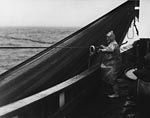






 |
|||||
 |
 |
 |
 |
 |
 |
|
|
Touring CulturesDean MacCannell (1992) has argued that 'Tourism today occupies the gap between primitive and modern, routinely placing modernised and primitive peoples in direct, face-to-face interaction' (p. 17), it is a movement and a meeting between the two. While the Films of Scotland travelogues are hardly concerned with the 'primitive', in their representation of the Highlands and Islands they nonetheless treat the inhabitants as culturally 'other'. As James Clifford (1988) argues, in the process of constructing and reconstructing 'coherent cultural others', there is always something 'torn off, as it were, to construct a public believable discourse' (p. 112). Clifford argues that this tearing off 'is simultaneously an act of censorship and of meaning creation' (p. 112). It is the kinds of meanings constructed by the travelogues that we are interested in here. |
|
The narrator in Hebridean travelogues, such as St Kilda - Britain's Loneliest Isle (1923), Over the Sea to Skye (1961), and Island of the Big Cloth (1971), verbally represents the inhabitants of the islands with the collective or general pronoun; 'the natives', 'the People', 'they'; age, sex, social position, occupation, are homogenised for the purposes of constructing a cultural 'type'. The camera presents these cultural types e as objects for us to observe; they never face the camera directly, they never address the audience, they are represented as the objects of a distinctly 'ethnographic gaze'. These 'cultural others' are typically represented at work; cutting peat, netting salmon, spinning, grinding, basket weaving, kelp burning, herring gutting. Further, they focus on particular kinds of work, work done by hand, with simple tools, outside in the natural environment. Even non-Highland documentaries such as Dunfermline (1974) and Tayside (1974) feature such images. 'Time has a gentle touch in the Hebrides' says the narrator of Enchanted Isles. The ethnographic gaze constructs the way of life in the Highlands and Islands as primitive, frozen in time; 'We have always made Tweed from our Highland wool', comments the narrator of Island of the Big Cloth (1971). |
|
 In Great Waters depicts the same heroic struggle between man and nature as Grierson's Drifters. |
In Grierson's (1938) radio talk on the 1938 Films of Scotland documentaries, he complained that: 'Occasionally, too, we have had travelogues of Scotland - all about the bonnie banks of Loch Lomond and kilts and bagpipes and other things that honest Scotsmen are heartily sick of - with an American commentary to demonstrate that the Americans were collecting us with other world curios' (p. 1). It is ironic that Grierson fails to foresee the way in which the travelogue will dominate the output of the second Films of Scotland Committee. His statement can only be understood in relation to his philosophy that documentary film provided the ideal medium for producing a social democratic state of educated citizens (cf. Aitken, 1991), and that as such it must be policed from its dangerously trivialising predecessor (cf. Grierson, 1979a, p. 35). But it his notion that to film a place and a culture in a travelogue is to collect it that interests us here. John Urry argues that 'tourism involves the collection of signs' (p. 3), and Dean MacCannell (1976) argues that tourist 'sights are "collected" by entire societies' (p. 42). Clifford argues that ethnography may also be seen 'as a form of culture collecting' (p. 231). Travelogues are a form of collecting in that they select, arrange, exhibit and preserve culture, even if this culture exists only on celluloid. Such collecting is meaningful because, as Clifford argues, 'the inclusions in all collections reflect wider cultural rules' (p. 218). The rule governing anthropological culture collection, he argues, is that what is collected is what seems 'traditional'. We can argue the same of the Films of Scotland travelogues. Their collection of scenes of working methods is determined by that which is thought to belong to that culture's primitive past. |
|
Benedict Anderson (1983) argues that the nation is 'conceived as a solid community moving steadily down (or up) history' (p. 30). The travelogues focus on traditional working methods is the product of a desire for identity. The surviving practices they collect give continuity to the collecting culture itself; representation of the cultural other is simultaneously representation of the former primitive self. While the Highlands and Islands have long served as one of the constructs of difference for British mainland culture, they have also served as a source of identity. |
|


|
|
| Author: Richard Butt | Images are drawn from the SCRAN database. |